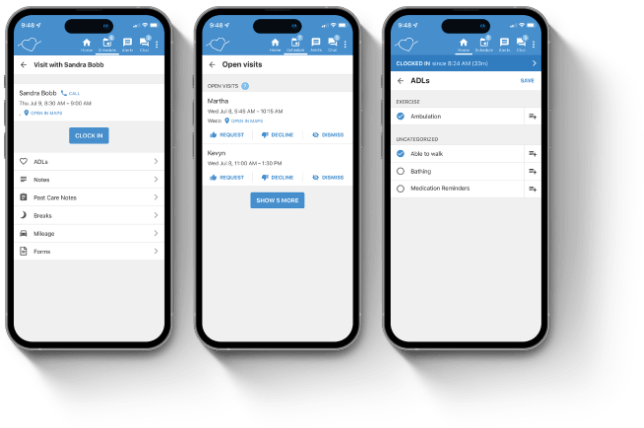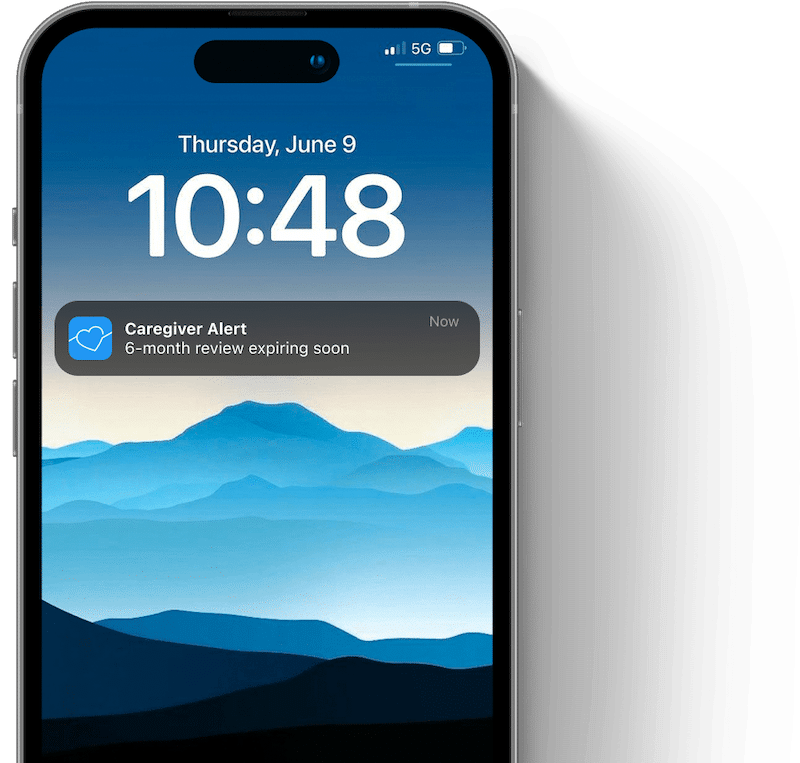Home Care’s Most Trusted EVV Software
We Are Your Electronic Visit Verification Experts
Equip your home health agency with AxisCare Electronic Visit Verification (EVV) software to stay compliant, streamline your operations, and provide personalized care.


Electronic Visit Verification
As the demand for in-home caregivers rises, modern digital solutions, like EVV software, are transformational for agencies that aim to provide exceptional care. Using EVV software allows agencies to capture key information, including the following:
- Services performed
- Patient receiving the service
- Date of the service
- Location of service
- Individual providing the service
- Start and end time of the service


Real-Time Visit Verification
Capture all essential care details and required visit information for EVV compliance from our user-friendly mobile app or telephony software.
- Allow caregivers to clock in and out using a mobile device
- Utilize GPS tracking for caregivers
- Reduce administrative burden with automated record keeping
Automated Scheduling & Billing
Utilize automated scheduling and billing tools to optimize schedules, digitize timesheets, and ensure caregivers get paid on time.
- Send open assignments to available caregivers
- Reduce scheduling errors with real-time availability
- Get next-day funding for qualified merchants


Enhancing Care Quality
Provide caregivers access to well-documented care plans to empower them to meet the unique needs of each patient.
- Improve visibility with AxisCare’s client and family portal
- Sync with Electronic Health Records (EHRs)
- Ensure clients receive care on time with AxisCare’s scheduling tool
Electronic Care Plans & Documentation
Keep track of all electronic care plans and documentation in one place where employees can customize, access, and edit while maintaining visibility.
- Give clients and caregivers easy access to forms from their devices
- Update care plans in the client and family portal for increased transparency
- Track revenue, hours of care provided, referrals, and more in a central location


Customizable Alerts & Notifications
Facilitate real-time communication for caregivers, administrators, and clients with customizable alerts and notifications.
- Set alerts to remind caregivers to clock in and out
- Send visit reminders to caregivers to reduce no-shows
- Remind caregivers to administer medication with customizable reminders
Ensuring Compliance With EVV Regulations
Verify services performed as well as the client, date, location, provider, and start and end time of every service to ensure compliance with EVV regulations.
- Request documentation that demonstrates adherence to EVV regulations
- Automate EVV processes to avoid penalties and consequences
- Ensure that you are compliant with your state’s approved EVV methods

Please Select Your State for EVV State-Specific Details:
Product Tour
EVV: Setting Up Client Authorizations in Minutes
Product Tour
EVV: Real-Time Authorization Utilization Reporting
Electronic Visit Verification (EVV) FAQs
AxisCare works with many EVV software vendors, including HHAeXchange, Sandata, AuthentiCare, CareBridge, and Netsmart. Visit the map above to see how AxisCare is working with your state to provide an EVV solution.
If your state follows an open model, like New Jersey, you can choose AxisCare or other EVV solutions that meet your state requirements.
If your state follows a closed model, your organization must use the state-mandated system to collect the EVV data. However, you may choose to use AxisCare alongside the state-mandated system and benefit from the many advantages of our platform.
AxisCare meets federal EVV requirements and empowers agencies to provide better care and grow their business. Contact us today to schedule a live demo.
EVV solutions benefit both caregivers and clients in several ways. For caregivers, it ensures accurate record-keeping, simplifies tasks, and enhances communication. Clients benefit from increased transparency, knowing when and by whom services are provided, which enhances trust in the care they receive.
Yes, we prioritize data security and privacy to maintain client and caregiver information confidentiality. Our EVV software uses encryption and secure data transmission to be secure and compliant with privacy regulations like HIPAA.
EVV software verifies the delivery of authorized care, reduces fraud and abuse, and improves accountability. It also helps detect and prevent billing issues and errors to ensure all parties are paid and billed on time.
EVV improves the quality of care by ensuring clients get personalized care on time. Additionally, EVV software captures vital health data during visits, increasing transparency between clients, caregivers, and agencies.
No, the AxisCare visit verification tool uses GPS to record caregiver location from when they clock in for a service visit until they clock out.
Home Health Care Services (HHCS) or Personal Care Services (PCS) that do not require an in-home visit are not subject to EVV requirements. Additionally, 24-hour HHCS or PCS are not subject to EVV requirements.
Schedule a Demo
Making the Switch has Never Been Easier


Fill Out the Demo Request Form
Ready to transform your business? It all starts here. Fill out this short request form, and one of our dedicated team members will be in touch. We understand your time is valuable, and we're committed to making this process as convenient as possible.
Get a Free Demo
Experience the power of our home care software solution firsthand. Once you've submitted your request, we'll schedule a personalized, no-obligation demo just for you. Our experts will walk you through the features and benefits that can revolutionize your business. It's a chance to see the future of your success.
Scale Your Business
After the demo, you'll be equipped with the knowledge and insights to make an informed decision. Start implementing our solution and watch your business flourish. With our support and your ambition, the sky's the limit.







